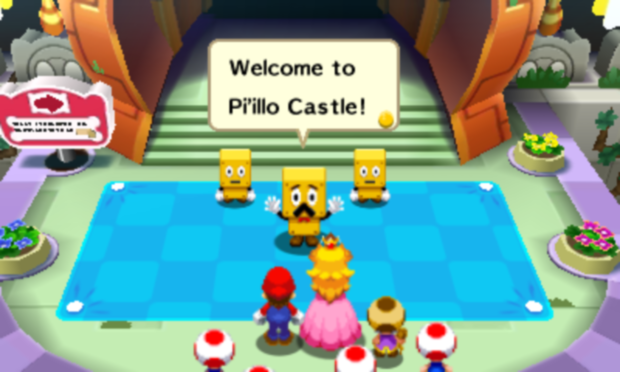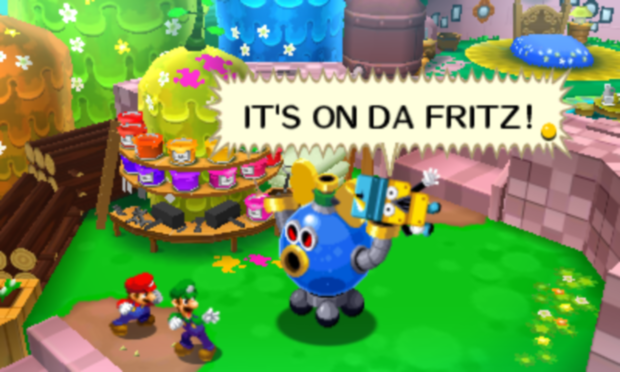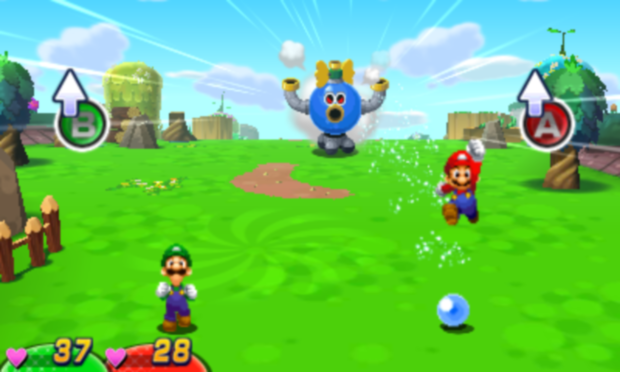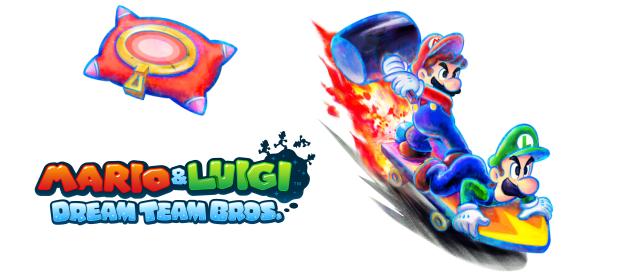Mario is either the long-suffering boyfriend type, or just really dense. Princess Peach has been captured more times than I’ve had birthdays (and I’m old, for the record), yet not once does he have any form of tantrum, nor even a calm chat about her taking self-defence lessons. So it’s not a surprise, then, that Dream Team Bros. features her ladyship being kidnapped yet again.
It must be a standing joke at Nintendo that Mario needs a holiday, but developer AlphaDream mark the opening of their latest RPG starring Mario and the gang with humour that pervades the entirety of the Dream Team Bros. experience, because it’s whilst on a (dubious, let’s be honest) gift of a long-overdue holiday, that the Princess is somehow stolen away into a world made entirely of dreams, which (conveniently) only Luigi can access easily.
And Luigi is the comic foil for a lot of the jokes, too. The bumbling, borderline simpleton nature of his character provides slapstick japes, and it’s his ability to fall asleep on these magical pillow portals so quickly (tantamount to narcolepsy, really) that enables Mario access to the dream world. The basic concept is that Mario enters through Luigi’s dreams, whereby Luigi joins up with his brother and has some semblance of control over the universe as it is, after all, the playground of his dreams.

All of this takes place in the land of Pi’illo (Pie-illow? Pillow? Pee-looow?), and after an initially confusing first rescue event that causes the brothers to awaken the original Prince Dreambert of Pi’illo, that their Princess is kidnapped and the daring adventure begins: Restore the land of Pi’illo to its once great state, and if you do that, you just might find some information pertaining to the Princess.
But this isn’t your typical Mario adventure; this is the fourth in the series of Mario & Luigi titles and thus, there are a few things to note. Firstly, this is very much “baby’s first RPG”. Of course you can die, but there is an incredibly lengthy tutorial process which plays out over a good 5 hours of the game’s opening. Each mechanic is rolled out to players in a painfully slow manner, with detailed instructions and often with forced tutorial battles. To a newcomer to the genre, this is probably welcome – I say probably, because it’s actually hard to imagine anyone not getting irritated after a few hours – but to an RPG stalwart who just happens to be excited to play the new Mario & Luigi, it’s borderline painful to endure, and is only doable thanks to the stellar script and comedic characters (the ‘Allo ‘Allo-styled French character is a particular highlight early on).

Those of you who are used to Role Playing Games will, for the most part, feel completely at home, especially if you’re a fan of turn-based games. Simplistic attacks are on offer, but there is additional interaction that tasks you with hitting the attack button a second and third time as you bounce on the enemy for additional damage. Defensive moves are also more interactive than traditional RPGs, and every enemy in the game will have a visual tell, indicating which of your party it is going to attack. Whilst never devolving into a full-on 2D platformer, there are similarities, and you’ll often have to make Mario or Luigi jump at the right moment to avoid an attack, instead causing counter-attack damage. It’s an interesting idea that removes a lot of the dice-rolling normally expected in RPGs, instead making you responsible for how much damage is caused, how well you defend, and any counter-attack damage caused – it’s all about reacting accordingly.
In addition to the basic attack and defence mechanics, there are Bros. attacks – which are better known as magic attacks. These are unlocked by finding attack blocks in the overworld, of which there are a set number in any given area, and finding them all will unlock a new Bros. attack. Yet again, these reinforce player control, as each Bros. attack pulls both Mario and Luigi out of the standard battle field, and joins them up to attack the enemies together. For example, the first you gain is the red shell attack: Mario will pull out a red shell and kick it toward the enemy, Luigi then needs to kick it as it rebounds, then Mario again… and repeat until the final devastating attack. Like all of the other in-battle combat, it’s fun to begin with, but you may find yourself wishing it was automated; I know I did.

Outside of battle, controls are very simple: Mario is the lead character, but (just like in battle) each brother has his own jump/action button. In battle, Mario’s attacks are executed with the A button, and Luigi has the B button. When exploring the non-battle sections, those same buttons make the brothers jump (one at a time, or both together if you hit both buttons), or with a quick tap of the shoulder button, the jump button is modified to an alternative action. It’s cleverly done, because (for example) once unlocked, the hammer is an in-battle item that can attack certain enemies – perhaps they have spikes on their heads, so cannot be jumped upon – and defend, too, but also allows access to areas of the map that were previously inaccessible. In many ways, Dream Team Bros. is like a Zelda title during the non-battle sections.
Once you enter the Dream World, however, the mechanics change up again. Whereas previously you’d be controlling both Mario and Luigi in battle, here you control just Mario, and the game becomes more of a side-scroller. Luigi goes “inside” Mario (and I tried to find a better description of that, but I couldn’t), and the third button press during an attack, if successfully executed, will cause multiple Luigis to rain down on the enemy for much more damage than you’d otherwise get. Controlling just Mario in the Dream World battles also allows for a more focused defence; because you know that every attack is aiming for him, there’s less worry about the tells and who the enemy is actually targeting.

Luigi is the star of the Dream World, though, and he can enter certain elements of the environment. The earliest example is a weird, sort-of plant, which looks like Luigi. Entering it (using the trigger/action modifier) allows you to pull at the moustached plumber on the touch-screen. As the moustache is pulled, so is the plant, and it can be used to fling Mario to otherwise unreachable locales. Another example is a background tornado-looking thing, which Luigi can jump into, and then, if you tickle his nose (again on the touch-screen) he will sneeze and force background items into the foreground, or move something from a left position to a right position.
It’s these that make up most of the puzzle elements – certainly in the dream world – and once you finish an area, you’ll usually face a boss, or find the nightmare fragments which are holding a Pi’illow resident hostage. It’s all about progression, of course, and this is hefty game that will keep any player going for a long time.
The levelling system is actually pretty neat. As you gain experience, a flag will raise up the pole towards each level-up moment. Traditional skills such as attack, defense, speed, etc, will upgrade each time you level up, but there’s is also a randomiser each time, too. You simply have to choose which skill you want to level further, then hit the A button as a slot machine spins. You can get up to +4 each time you do this, but there’s an even further addition to the ideal: after levelling a set number of times, you can upgrade your skills. You cannot undo or re-pick these, so you have to choose wisely, but they range from faster levelling to higher overall stats. It’s a really nice idea that gives every player a more individual experience, in what is (after all) a heavily story driven adventure.

The overworld is a pretty and colourful 3D place, and exactly what you’d expect a Mario game to look like. It’s not as gorgeous as, say, Super Mario 3D Land, but it does the job and there’s a slightly cartoon-y feel to it. The dream world is even more brightly lit, with pastel colours making it even more cutesy, if such a thing were possible. Dream Team Bros. suffers a little in the audio department, because the soundtrack is also suitably cheery and upbeat, but the length of time spent in any given area can cause it to be a little grating. It’s not poorly composed, per say, but each piece of music feels a little phoned-in, and given how long you’ll be playing for, there’s serious potential that it could get annoying – your mileage may vary.
VERDICT: Dream Team Bros is a great gateway game, which is something Nintendo do very well. It could inspire a new generation of RPG players, whilst keeping fans of the cheery, Mario visuals we’re all used to happy as well. An often cheeky script is most welcome, but it’s worth remembering that you’ll be playing for a good five hours before you’re really let loose in the land of Pi’illo. It doesn’t reinvent the wheel and really struggles to get going, but for the most part it’s a nice variation on many mechanics we already know and love.
 GOOD. A game that scores 7/10 is worthy of note, but unworthy of fanfare. It does many things well, but only a few of them incredibly well and, despite a handful of good qualities, fresh ideas and solid mechanics, it fails to overwhelm.
GOOD. A game that scores 7/10 is worthy of note, but unworthy of fanfare. It does many things well, but only a few of them incredibly well and, despite a handful of good qualities, fresh ideas and solid mechanics, it fails to overwhelm.






